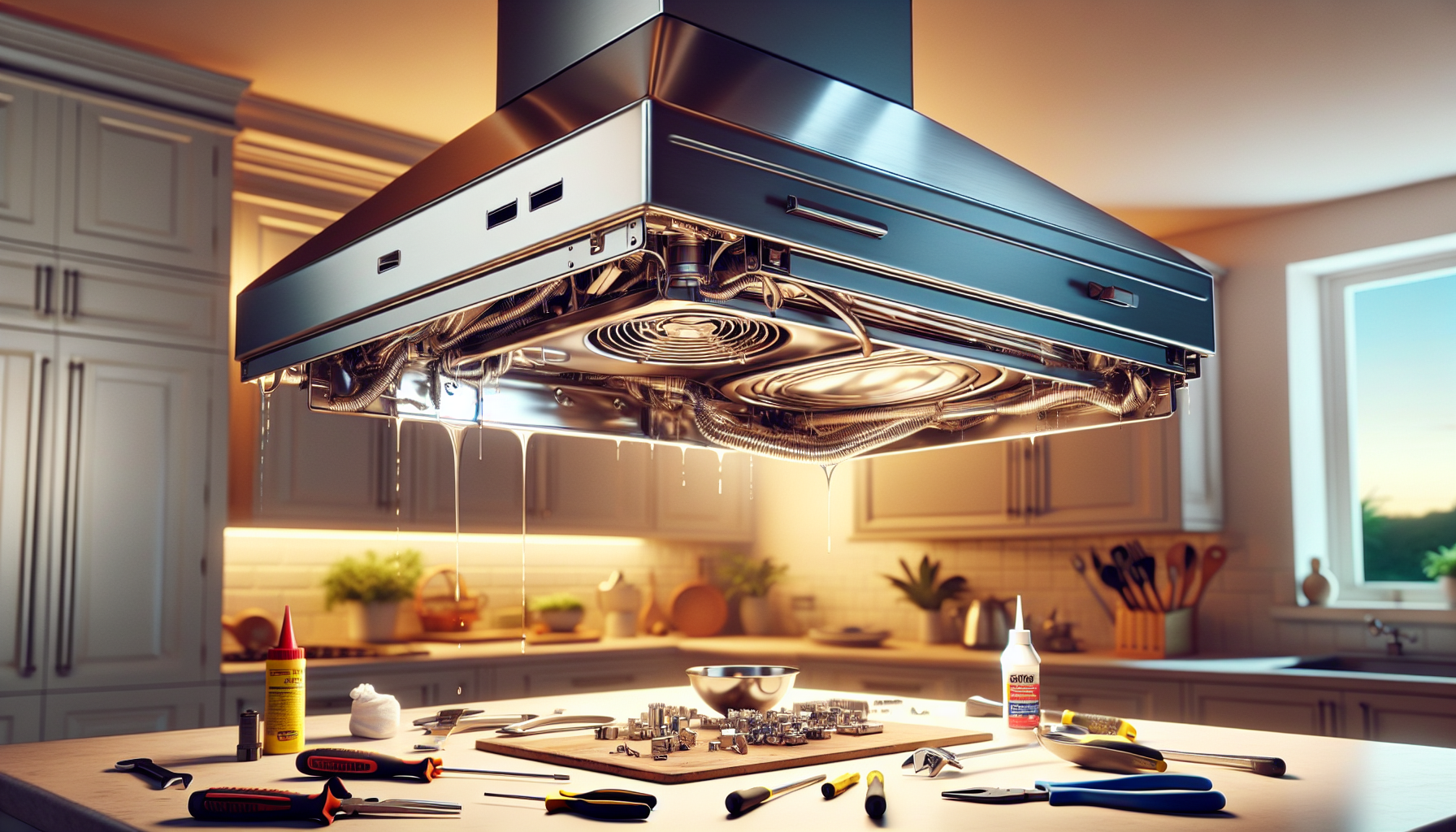
How to Address a Leaking Range Hood in an Elica Hood Without Flue Pipe
In this guide, you'll learn how to address a leaking Elica hood without a flue pipe. We'll cover the common causes of leaks, how to pinpoint the source of the problem, and provide a step-by-step repair guide. By the end, you'll have the knowledge to tackle this issue and keep your range hood working properly, ensuring a smoke-free and comfortable cooking space.
Understanding Elica Hoods Without Flue Pipes
When you're looking for a suitable range hood for your kitchen, you might come across Elica hoods without flue pipes. These innovative appliances, also known as flue-less hoods, offer a unique solution for kitchens where traditional vented hoods are impractical or impossible to install.
Types of Elica Hoods Without Flue Pipes
Elica offers two main types of hoods without flue pipes:
-
Filtering Hoods: These hoods recycle air back into the kitchen after removing odors and particles.
-
Extractor Hobs: An innovative solution that integrates a fume removal system directly into the hob itself.
How Flue-less Hoods Work
Flue-less hoods operate by filtering and recirculating air rather than venting it outside. They typically use a combination of filters:
- Grease Filters: Remove greasy and oily substances from cooking fumes.
- Activated Charcoal Filters: Eliminate odors from kitchen fumes.
The filtering system is the core of these hoods, capturing odors, fumes, and cooking grease. High-quality ceramic filters can achieve filtering efficiency levels of over 80%.
Benefits of Flue-less Hoods
- Easy Installation: No need for complex ductwork or exterior venting.
- Space-Saving: Usually take up less space than traditional hoods.
- Flexible Placement: Can be installed in various kitchen layouts.
- Energy Efficiency: Helps maintain indoor temperature by not venting air outside.
- Improved Indoor Air Quality: Filters and recirculates clean air back into the kitchen.
When choosing a flue-less hood, consider factors such as stated filtration level (aim for higher than 60-70%), average filter life, and the hood's size and appearance to ensure it fits your kitchen's style and needs.
Common Causes of Leaks in Elica Hoods
When you're dealing with a leaking Elica hood, it's essential to understand the common causes behind this issue. By identifying the root of the problem, you can take appropriate steps to address it effectively. Let's explore the main factors that can lead to leaks in your Elica hood.
Condensation Issues
Condensation is a frequent culprit when it comes to leaks in range hoods. This phenomenon occurs when hot cooking fumes come into contact with the cooler surface of the hood. The temperature difference causes humidity to form, which then transforms into water droplets. This can be problematic for two reasons:
- Surface wear: Over time, condensation can damage cabinet surfaces and decrease the extraction system's efficiency.
- Potential dripping: Condensation forming in the initial sections of the duct can easily drip onto your hob, compromising both hygiene and safety.
To combat this issue, some Elica hood models are equipped with a No Drip system. This innovative feature works by heating the hood surfaces to about 40°C, significantly reducing condensation formation.
Faulty Seals or Gaskets
Another common cause of leaks in Elica hoods is faulty seals or gaskets. These components play a crucial role in maintaining the hood's integrity and preventing air and moisture from escaping. Over time, seals and gaskets can become worn or damaged, leading to leaks. Regular inspection and timely replacement of these parts can help prevent this issue.
Clogged Filters
Clogged filters can contribute significantly to leaks in your Elica hood. When filters become blocked with grease and debris, they impede proper airflow. This restriction can lead to condensation buildup inside the hood, eventually resulting in leaks. To maintain optimal performance and prevent leaks, it's crucial to clean your hood's filters regularly.
Diagnosing the Source of the Leak
To address a leaking Elica hood without a flue pipe, you need to pinpoint the source of the problem. Here are some effective techniques to help you diagnose the leak:
Visual Inspection Techniques
Start by carefully examining your range hood. Look for signs of water droplets, stains, or dampness on the hood's surface, especially around the filters and electrical components. Pay close attention to the wire mesh, as it's a common area for condensation buildup. Check for any pooling water around the motor casing and electrical wires.
Testing for Condensation
Condensation is a frequent cause of leaks in range hoods. To test for this:
- Turn on your hood while cooking a pot of boiling water.
- Observe the hood's surface, particularly the wire mesh and diffuser units.
- Look for water droplets forming on these surfaces.
- After turning off the hood, watch for any dripping water.
Remember, condensation occurs when hot cooking fumes meet the cooler hood surface. Some Elica models feature a No Drip system that heats the hood surfaces to about 40°C, reducing condensation formation.
Checking Filter Condition
Clogged or poorly maintained filters can contribute to leaks. Inspect your filters:
- Remove the grease filters (usually aluminum or stainless steel).
- Check for excessive grease buildup or damage.
- If your hood uses charcoal filters for odor removal, examine their condition.
Regular filter maintenance is crucial for optimal performance and leak prevention. Clean metal filters monthly with gentle detergents, either by hand or in the dishwasher at a low temperature. Replace or regenerate charcoal filters as per the manufacturer's instructions.
Step-by-Step Leak Repair Guide
Addressing Condensation Problems
To tackle condensation issues in your Elica hood without a flue pipe:
-
Identify condensation-prone areas: Check the wire mesh, diffuser units, and motor casing for water droplets or pooling.
-
Improve ventilation: Ensure proper airflow by keeping the kitchen well-ventilated during cooking.
-
Use the No Drip system: If your Elica hood model has this feature, activate it to heat the hood surfaces to about 40°C, reducing condensation formation.
-
Install a condensation collection tray: For hoods equipped with the No Drip System, ensure the tray is properly positioned to collect any condensation that forms.
Replacing Faulty Seals
To replace faulty seals in your Elica hood:
-
Inspect the seals: Check for wear, damage, or deterioration around the hood's edges and joints.
-
Purchase replacement seals: Obtain the correct seals for your specific Elica hood model.
-
Remove old seals: Carefully peel off the old seals, ensuring no residue remains.
-
Install new seals: Apply the new seals, ensuring a tight and even fit around all edges.
Cleaning and Replacing Filters
To maintain optimal performance and prevent leaks:
-
Clean grease filters monthly: Use gentle detergents and wash by hand or in the dishwasher at a low temperature.
-
Inspect charcoal filters: If your hood uses these for odor removal, check their condition regularly.
-
Replace or regenerate filters as needed:
- For long-life filters: Wash every 2-3 months with hot water and mild detergents, or in the dishwasher at 65°C. Dry in the oven for 10 minutes at 100°C.
- For ceramic filters: Regenerate in the oven every 2-3 months at 200°C for 15 minutes.
-
Use Elica's cleaning products: Consider using their specialized cleaning set for optimal results.
Conclusion
Addressing a leaking Elica hood without a flue pipe is crucial to maintain a clean and efficient kitchen. By understanding the common causes of leaks, such as condensation issues, faulty seals, and clogged filters, homeowners can effectively diagnose and fix the problem. Regular maintenance, including cleaning filters and checking for wear and tear, plays a key role in preventing leaks and ensuring optimal performance.
With the right approach and tools, fixing a leaking range hood becomes a manageable task. By following the step-by-step repair guide, from tackling condensation problems to replacing faulty seals and maintaining filters, you can keep your Elica hood in top shape. Remember, a well-functioning range hood not only improves air quality but also enhances the overall cooking experience in your kitchen.
FAQs
How can I fix a leaking range hood?
To address a leaking range hood, follow these steps:
- Inspect for any blockages within the range hood.
- Ensure that the exhaust pipe's airflow is not obstructed where it meets the wall.
- Check for any cracks or holes in the range hood.
Is it acceptable to use PVC pipe for venting a range hood?
No, the ductwork for a range hood should be constructed from rigid metal, such as galvanized steel or stainless steel, with a smooth interior surface. Using metal or plastic flex ducts, including PVC, is typically against code for kitchen exhaust systems. However, PVC ducts may be used for downdraft exhaust systems.
Is a flue necessary for a range hood?
No, range hoods do not necessarily need to be vented outdoors. While ducted range hoods, which connect to the outside, are generally preferred for their efficiency, ductless hoods are available and operate without external venting.
Can a cooker hood operate effectively without external venting?
Yes, it is possible to have a cooker hood without external venting. However, it's important to note that without an external vent, humidity and cooking odors have no direct exit, potentially leading to moisture problems and mold growth. Thus, proper ducting is recommended to ensure a clear pathway for extracted air and contaminants to leave the home.


